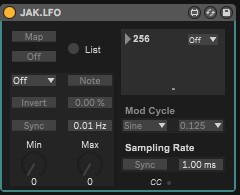JAK.LFO
Dec 2018
30
The LFO is by far my favorite utility in production. I really enjoy the way I can do so much with it. There are many M4L LFOs out there, but in every case, there was something I did not click with me, or it had a feature I did not want. For my own artistic needs, I wanted something that was compact – so I could route LFOs to LFOs and so on – all without having to navigate too much. I also needed something that could produce more interesting waveforms than the standard Sine, Triangle, Square, Saw, Noise.
Features
- Classic Waveforms – Sine, Triangle, Saw, Square,
RandomStep , RandomSmooth - Waveform Inversion – Makes a Saw ramp downward instead of upward, for example
- Hz or Synced Modes – Synced mode from 128n up to 32 bars (or more with Mod Cycle – see further below)
- Note Trigger – When enabled, LFO phase resets on each incoming MIDI Note On message (this is why JAK.LFO is a MIDI Effect; Audio Effects cannot receive MIDI without sloppy workarounds)
- Pulse Width – Control of Square, or “Point Whereabouts” of Triangle waveform. PW is typical for the Square. PW for Triangle at 50% will produce… a triangle, with the point in the center. At 0% you will have a Saw ramping down; at 100% it will ramp up.
- ModCycle – This is where JAK.LFO steps away from being a generic effect to an advanced modulation device. The same premise behind FM synthesis, or routing an LFO to itself, or routing an LFO to another LFO, is what is behind this. Modulate a carrier wave (the XShape param) with a rate-multiplied Sine wave (set by the XRate param). XRate = Rate * XRate. For example, if your Rate is set to 1n (1 bar), and your XRate is set to 8, you will have a greater modulation that cycles every 8 bars, with 1n modulations fading in and out accordingly. The XRate can also be smaller than the Rate (when XRate < 1.), which creates sub-divisions. A waveform scope is included on the device to better aid using this option.
- SR (Sampling Rate) Control – The ultimate effect of this is like a square wave version of Mod Cycle, though it works differently, the end results in similar. The LFO engine is producing an audio-rate signal that is being sampled every 1 millisecond to produce usable control data. By making the sample rate slower, we are effectively applying a sort of bit reduction, adding tiny steps to our output waveform. The SrRate can be set in ms, or for more musical purposes as note-values just like the synced LFO. If you have a sine at
1n, and set the SrRate to 16n, you will end up with a down-sampled sine wave modulation that only moves in 16n increments – very cool for musical purposes. All sorts of staircases can be made, though often phase cancelation can happen depending on your settings. You can use it with the Mod Cycle feature to create wild shapes. - Other Features –
- Destination Min and Max
- Instant mapping or List-browse (old school style) mapping
Very low CPU consumption
- Very compact UI so you can have multiple of these side by side and still be able to see their settings
- MIDI-to-CC
- Info View help (hover over any parameter while Live has info view open for detailed descriptions)

